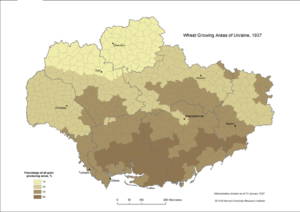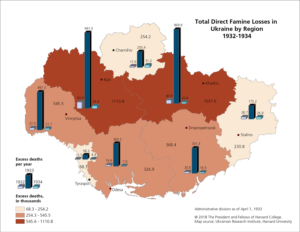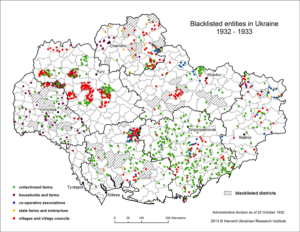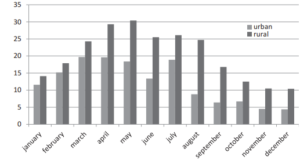Historical Background
Chapter 3: “Murder by Starvation”: The Holodomor
Anthony Smith, Joshua Caskey, and Griffin Stead
Truth alone does not always lead to answers. What separates meaningful history from simply ‘factual’ history is using context and analysis to describe any one medium. Pertaining to the Holodomor, or ‘death by starvation’ in Ukrainian, simply writing it off as just a mass starvation seen countless times through history undermines its significance as a catastrophe bred out of more than human error. This specific famine was directly caused by the decisions made by Stalin’s government. By detailing the Soviet’s encroachment in Ukraine during and in the decade before the catastrophe, this chapter aims to prove why the Holodomor was more than a famine: it was a very intentional disaster perpetrated by Stalin’s regime as another way to suppress Ukraine. As long as Ukrainians have fought for an identity and political autonomy in the world, it has been encroached by regimes seeking to exterminate its existence by any means necessary. In the span of a single year from 1932-1933, millions of Ukrainians starved to death(Harvard University, MAPA Digital Atlas of Ukraine). Far beyond an event effect by drought or other natural causes, this man-made catastrophe was a deliberate genocide against the people of Ukraine, a ‘murder by starvation’, according to the well known Ukrainian historian Timothy Snyder.
Before turning to the Holodomor, it is important to review legal and internationally accepted definitions of genocide. The United Nations decided during the Genocide Convention of December 1949. According to that definition, genocide is “a crime committed with the intent to destroy a national, ethnic, racial or religious group, in whole or in part.” It does not include political groups or what has been termed “cultural genocide”. (United Nations Office… Protect). Not all historians agree on whether the Holodomor should be classified as a genocide, so it is important to understand the formal definition before examining the famine. The most important aspect of this definition is the idea that annihilation of a particular group is intentional. The most controversial aspect historians debate with regard to the Holodomor is whether the famine was an intentional killing of Ukrainians specifically, or whether it was a series of large-scale errors and economic failures, combined with disregard for human life in the Soviet Union under Joseph Stalin.
Understanding how Joseph Stalin and the Soviet Union worked is a crucial part of how the Holodomor occurred. Stanislav Kulchytsky, a Ukrainian historian, was hired by the Soviets in 1986 to expose how ‘capitalists’ were lying about the Holodomor, since scholars in the West had begun conducting their own research into the events that led up to the Holodomor(Levy, A New View Of a Famine That Killed Millions). However, Kulchytsky came to the conclusion that the Holodomor was in fact a genocide(Kulchytsky, xv). In his works, he puts a great deal of emphasis on the economic and political environment in which the events occurred. In the early 1920s, Lenin adopted a policy known as war communism. This was the first ‘communist onslaught,’ according to Kulchytsky. The purpose of this policy was to promote communist practices such as collectivization and the abandonment of money-commodity relations within the state.
However, this onslaught caused a lot of economic damage and subsequent conflict. This conflict caused Lenin to reverse his stance on war communism, saying it was a necessary policy during the civil war, before abandoning that policy and adopting the New Economic Policy (NEP). This policy allowed more free markets once people paid a tax to the state. For our purposes, we understand the NEP as the ability of farmers to sell grain. This policy marks a contrast between Vladimir Lenin and Joseph Stalin, and therefore a key difference between the 1920s famine and the Holodomor. After Lenin became ill and receded from the leadership in 1924, he compromised on the collectivization policy and settled for cooperative farms.
From 1929 to the early 1930s, Stalin led another ‘communist onslaught,’ according to Kulchytsky(Kulchytsky, xxv). During this period, he formed a centralized economy by forcing collectivization of all the farms. This economy was dictated by the centralized government in Moscow. This form of economy could not function in a non-authoritarian state, as it had similar consequences as Lenin’s communist onslaught and would cause severe economic problems. Stalin kept advancing this form of economy and forced it into existence by using punitive actions, such as the famine in Ukraine from 1932 to 1933 that later came to be known as the Holodomor. This type of economy was known as the ‘command economy’, meaning that Stalin’s government could control it directly. By collectivizing agriculture, Stalin in theory would have been able to control how grain was produced and how it was used. Stalin’s plan for the grain was to spur industrialization and increase the strength of the Red Army. Stalin’s goal was not only to be a dictator politically, but also to rule economically, so that the citizens of the USSR would be fully dependent on the state, and thus forced to remain loyal to the Communist Party and the party’s objectives.
In the USSR, Ukraine was a major producer of grain(Fig 1), and the most populous Soviet Socialist Republic(SSR) outside of Russia itself. The Holodomor which means “death by starvation” was a period of mass starvation in Ukraine and the Kuban, a region bordering Ukraine that wanted to integrate with Ukraine, lasting from 1932-1934. The peak in deaths was in 1933(Fig 2).The Holodomor resulted in the deaths of about 3.9 million Ukrainians which was a significant portion of Ukraine population at the time (29.6 million). The distribution of these deaths varied across the Ukrainian SSR. Kyiv and Kharkiv oblasts in central Ukraine had the most deaths, representing more than double than Vinnytsia, the oblast with the next highest death toll, The least affected oblasts were the agricultural oblasts of Dnipropetrovsk and Odessa. The overwhelming majority of these deaths (3.6 million) occurred in rural areas, while only 0.3 million occuring in cities. This may seem odd, as one would normally think that since the countryside is where the food would be produced, it would be least affected, however in the Holodomor this was not the case. The reason for this difference was because the Soviet government prioritized grain aid for the more grain producing oblasts so the citizens there would still be able to produce grain. This practice is not limited to the Holodomor, in soviet gulags, only those who worked were fed(Harvard University, MAPA Digital Atlas of Ukraine).



When harvests did come, the soviet government requisitioned grain according to a predetermined quota. However due to these procurement plans, farmers began to grow less and less food since they would see no benefit from growing the food as the government always takes it. This is shown by a visit from the Polish General Consulate, who remarked that only one sixth of the farmland in Ukraine was plowed in fall of 1932. Thus, when the harvest of 1933 came, the government was unable to requisition the predetermined amount of grain because that grain didn’t exist. Instead of adjusting the goals, Stalin kept them as is. When districts were unable to procure enough grain, a blacklist was imposed on the district until their policies and grain procurement improved(Fig 3). These blacklists were brutal, they cut entire villages off from information, food, and consumer goods(Harvard University, MAPA Digital Atlas of Ukraine). These blacklists caused catastrophic levels of starvation and death. In reality, these blacklists wouldn’t have improved the procurement of grain, as no such grain existed, they were targeted efforts to exterminate what Stalin saw as a potential revolutionary Ukraine as Ukraine once did have an independent state and was the largest republic of the USSR except for Russia.
Another crucial part of the Holodomor is to understand how the soviets kept much of it a secret. Throughout and after the Holodomor, information about the Holodomor was suppressed by the Soviet state. This was done by only letting in socialist leaning journalists into Ukraine, the restriction of refugee movement, falsifying data such as the 1929 census to cover up the excess deaths, and exiling and executing people who discussed the famine(Kulchytsky, xx). This cover up was largely successful until glasnost, a policy of more openness and transparency in the USSR, began in the 1980’s. During this period, more information from the communist party archives became available. At this point governments around the world like the United States’ began investigations into the true nature of the 1932-1934 famine. Even then, the soviet government initiated its own ‘research.’ However the goal of this wasn’t to reveal the truth, but to manufacture a truth that absolves the communist party of wrongdoing. Even the lead researcher in this project, Stanislav Kulchytsky, found enough evidence to classify the famine as a genocide. Kulchytsky’s research into the Holodomor was a critical piece of evidence that led Ukraine to classify the Holodomor as a famine.
The Holodomor is not the only famine that occurred during the Soviet regime. In fact, around ten years earlier there had been a famine in Ukraine that had also affected many Ukrainians, with estimations from Historians ranging from around 300,000 and 1,000,000. (Rudnytskyi, 550). Famine was not uncommon in the Soviet Union. In his lecture on the Holodomor from 2019, well known historian Timothy Snyder cites this 1921-1923 Ukrainian famine when discussing the Holodomor, and describes the famine of the 1920s as a “lesson for Joseph Stalin.” (Snyder 2019). He argues that Stalin learned that famines are political. A major factor into the 1920s famine in Ukraine and the Volga region of Russia had been the weather. A drought in 1921 caused crops to be decimated, thus causing a food shortage. The Kremlin did not hide this information, and allowed international aid to help supply food. (Ryudnitski, 550). Nevertheless, there was a heavy death toll in Ukraine that was caused by Russia’s disregard for Ukrainian peasants. Ryudnitski estimates the deaths caused by hunger during this period being around 600,000. (Ryudnitski, 550). The death toll was much higher proportionately in rural regions than in urban regions. Figure 4 is a graph made by Ryudnitski based on his calculations that highlights the deaths in rural and urban areas for every month of 1922 per 1000 Ukrainians. (Ryudnitski 558). The Russian government focused all the aid efforts that were being exercised into the Volga region in Russia by withholding information of the crisis in Ukraine from international aid organizations. (Ryudnitski 552). Russia did not allow information about the famine in Ukraine to be spread, and by the time aid was finally permitted to enter southern Ukraine, a great deal of damage had been done. The aid given afterward was still able to save the lives of hundreds of thousands of people. In the case of the Holodomor, however, the famine was not only not recognized by the Soviet regime, but also denied and declared to be an attack on communism by Ukrainian nationalists.

The Holodomor was also marked by more intentional policies targeting Ukrainian peasants, as Stalin was attempting to eliminate the “kulaks,” or wealthy Ukrainian peasants, who owned some of their own land. (Snyder 2019). He saw them as a threat to the Soviet Union and the collectivization effort, and made them choose between giving up their land to join the collective or being sent to the Gulag. This policy led to much resistance from Ukrainians, and many Ukrainians fled to surrounding countries such as Poland, Romania, and Lithuania. (Snyder 2019). The Soviet government’s expectation was that collective farming would be equally as efficient and effective as private farming, which proved to be untrue. Additionally, their quotas were based on the harvest of 1930, which was a very strong harvest. (Snyder 2019). When the 1931 harvest was less effective due to collective farming and worse weather, Ukrainians began to starve. In 1932, Stalin acknowledged the famine in other parts of the Soviet Union. One and a half million people had died in Kazakhstan as a result of the collectivization policy, and there were many who were starving in the southern regions of Russia. (Snyder 2019). Despite the clear and utter devastation in the Ukrainian countryside, Stalin did not acknowledge that the famine was occurring in Ukraine. In fact, Stalin singled out Ukraine as disloyal, declaring that what was happening in Soviet Ukraine was a result of Ukrainian nationalists who needed to be punished. (Snyder 2019).
1932 is also when “Soviet Policy takes a specific and unmistakably murderous turn against the Republic of Soviet Ukraine” (Snyder 2019). The Soviet Union began to block borders to prevent Ukrainians from fleeing the countryside into cities or other countries, and policies like the meat tax and Soviet economic blacklist devastated the Ukrainian peasants. (Snyder 2019). Snyder argues that if these policies from 1932 had been different, the death toll may have been in the hundreds of thousands as opposed to millions. These extremely harsh policies targeting Ukrainian peasants and outright denial of the famine occurring in Ukraine throughout its entirety are what separates the Holodomor from the famine of the 1920s. It is also what gives the Holodomor such a strong case for being labeled as a genocide. Foreign diplomats were very aware of the famine occurring in Ukraine, but this knowledge did not translate into policy or interference from countries. The main sources of information about the Holodomor at the time were Ukrainian refugees who had fled to Poland. After gaining some media attention, they addressed the League of Nations, which could not do anything at the time; the League attempted to work with the Red Cross, which could not get into Soviet Ukraine due to the border blockages.
Deconstructing the genocidal aspect of the Holodomor involves demonstrating that this famine was not natural, but caused by political factors extending far beyond grain output. Supporting this claim is Timothy Snyder of Yale, who extends the matter further to claim that almost every famine in history is due to politics rather than a mere “lack of food.” Either by poor distribution, or blockades of specific regions, the import and exporting of foods causes avoidable famines. One similar historical example is the Great Irish Famine, which resulted from the British crown’s decision to double down on single-crop dependance in Ireland and cripple the food market, after a potato blight had destroyed most of the crop in Ireland. A particularly vile fact behind this event is that during the famine, Ireland was still a net-exporter of food, since its colonial power, Great Britain, had forced Irish officials to ship what remained of the crop to England to protect its own population from similar devastation.
Parallels can be drawn in Ukraine to emphasize the political aspect of the famine, which has led to its categorization of as a genocide by various historians, intellectuals, and political leaders including Timothy Snyder, Pope John Paul II, and European Parliament(Ukrainian Museum). Beyond causing untold human suffering, the forced famine in Ukraine led to farmers whose land had been confiscated by the state becoming significantly less productive under the leadership of gosplan, the soviet agency that formulated the five year economic plans. In regards to Gosplan, this was Stalin’s appointed economic committee which was in charge of industrializing the nation. Most famously, they are responsible for the 5-year plans which saw Russia attempt to rapidly modernize its economy in five year intervals. For Ukraine, this meant forcibly taking farmlands into government hands to be used to feed Russia’s expanding working class. Using forced and hired laborers from elsewhere to maintain these collectivized farms meant that farmers working the land were not well adapted to it and therefore could not produce at the same rate as farmers indigenous to a region. As more land was collectivized beginning in 1928, those who had avoided persecution were made to work harder to achieve rising demands. A turning point was the 1928-29 growing season, which saw higher than expected grain yields across Ukrainian Russia due to especially favorable growing conditions that year (Fedorovych, “The Holodomor…Inexpressible”). Believing that this was a sign that farming was improving and that collectivization was growing in efficiency, the Soviet government raised the grain quotas for the following year to nearly double of the 1927-1928 season (Fedorovych, “The Holodomor…Inexpressible ”). For the 1930 season and onwards, Ukrainian farmers faced harsher and harsher circumstances and higher quotas imposed by the Soviet government.
As with all genocides, the Holodomor wasn’t a sudden shift in policy. This deliberate and systematic killing of Ukrainians throughout the 1930s did not occur in a vacuum, but represented the continued development of anti-Ukrainian policies and practices under Stalin’s regime. A decade previously, in the 1920’s, the term “dekulakization” has been used to describe the policies of Stalin in this period. Before understanding what this process was, one must first understand the idea of Kulak. This term, used by Stalin’s government, referred to a social class of farmers who owned large swaths of land and had the wealth to employ others to farm it. Of course, owning a significant plot of land and having enough resources to hire others was ideologically against the communist regime, which Stalin had been strengthening since his ascent to power. Within this context, “dekulakization” was merely the process to eliminate the ‘Kulak’ class from the Soviet Union. Ukraine being one of the most rural provinces, as well as the agricultural center, meant the majority of people deemed as “Kulaks” by the state were Ukrainian farmers.
One of the more heinous aspects of these policies, which intensified Ukrainian suffering and grain struggles even before the breakout of the famine, was the broad expansion of what it meant to be a Kulak(Fedorovych, “The Holodomor…Inexpressible”). Over the course of the 1920s and in the years immediately before the Holodomor, the term Kulak came to be extended to just anyone deemed to have more land than necessary. This was a systematic campaign that unfairly targeted Ukrainian farmers, and arguably helped cause the great famine to reach the devastating heights that it did, due to the erasure of thousands of farmers beforehand. In just 1930-1931, over 1.8 million kulaks were deported(Polian, Against Their Will … in the USSR), and it is estimated that 530,000-600,000 kulaks died(Hildermeier, Die sowjetunion, 1917-1991) throughout the entirety of dekulakization(not including the Holodomor). The Holodomor was simply the next step of dekulakization by broadening the term again to its final form, Ukrainian farmers as a whole.
Suffering during the famine was not experienced equally, with different regions and demographics seeing varying degrees of hunger and political violence. One harrowing phenomenon that was common across all of the Ukrainian lands was the disproportionate number of deaths of children. Over 40% of all deaths were of people under the age of fifteen. Part of this overwhelming proportion of children can be explained by Soviet policies which gave unethical power to youth. One of particular concern was a policy according to which if a child witnesses another family member committing any misconduct or illegal activity, they have an obligation to report it to authorities, with the added incentive of small rewards being distributed like food (Kuzovova, Childhood During the Holodomor).Coupled with widespread propaganda making this policy known, this was ingrained in the minds of vulnerable children, unbeknownst to the repercussions they would have to face. Through a single verbal testimony alone, it was enough for authorities to doom one’s parents to a life of imprisonment or forced labor and eventual premature death. This caused a divide in many households, as families knew they were at risk of imprisonment if unable to properly support their children. Cases of antagonistic parents who enshrined strict control over children to avoid being reported were common. If a child was successful in incriminating their parents, there was no policy set in place to support these now orphaned kids and they would just die of starvation alone (Kuzovova, Childhood During the Holodomor).
While the Holodomor was clearly an intentional act of genocide for most observers and scholars, not all historians agree that it should be categorized as such. According to the Parliament of the United Kingdom, only 35 countries have acknowledged the Holodomor as a genocide; and until December 2022, the European Parliament had only recognized the Holodomor as a “crime against humanity,” not a genocide. (Brader). Historians and Stephen G. Wheatcroft and Robert Davies argue against classifying the Holodomor as a genocide, focusing on intent, citing economic complications as well as secret relief efforts carried out by the Soviet government. Stephen G. Wheatcroft, for instance, argues that those who argue that the Holodomor was a genocide on Ukrainians carried out by the Soviet Union do not recognize the economic complexity of the context, adding that there was not an easy solution that Stalin could have implemented to stop the famine. (Wheatcroft 465-466). He also argues that there was a serious grain shortage between 1932-33, and that while the policy implemented by Stalin was harsh and did not account for that shortage, the Soviet government underestimated the severity of grain shortages.
Stalin’s true motives may never be known, so it will likely be debated into the future whether the Holodomor should be classified as a genocide and as an intentional, man-made famine, or as a crime against humanity as an accidental, man-made famine. While it may seem pointless to argue the intention, the result was millions of Ukrainians dying from starvation, (Snyder 2019). Regardless of whether that was what Stalin had planned for or not, it is important to note that this event is just one of many throughout history in which Russia has persecuted and systematically persecuted and systematically caused the mass death of Ukrainian life. As Ukraine currently tries to defend itself from Russia’s ongoing invasion, it is important to remember how Russia has targeted Ukraine many times throughout history, and that many Ukrainians today view the ongoing violence in their homeland as just one more point on the continuum of Russian, state-sponsored oppression.

